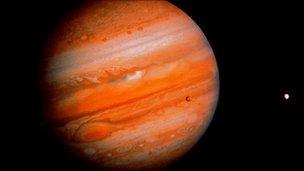Impacts 'more likely' to have spread life from Earth
-
Published

The hardiest life forms of Earth could have made it to Jupiter or its moons
Asteroid impacts on the Earth may have scattered more life-bearing debris to Mars, Jupiter or beyond our Solar System than previously thought.
Vast computer simulations, external of debris thrown up from Earth impacts show 100 times more particles end up on Mars than prior studies have shown.
The highest-energy impacts drive debris all the way to Jupiter, which hosts two moons that may be amenable to life.
Only the hardiest of Earth's organisms could have survived the trip, however.
The study considers a reverse of the "panspermia" idea that occupies much of meteoritic research - namely, that the precursors to life, or life itself, may have been delivered by an impact on the early Earth.
Equally, however, Earth impacts may throw up debris that could be loaded with microbes or small, hardy organisms like water bears - which have already demonstrated the ability, external to survive the harsh conditions of space.
Other simulations have tackled the probability that Earth impacts seeded life in the Solar System, suggesting that Earth debris could even have made it to Saturn's moon Titan, external.
Now, Mauricio Reyes-Ruiz of the National Autonomous University of Mexico and his colleagues have carried out the largest-ever simulations of the process, each of more than 10,000 particles being ejected from the Earth's surface and described in their as-yet unpublished manuscript.
Each of the five simulations considered impacts of varying violence, with the particles shooting off at ever-increasing speeds.
The particles were then allowed to escape the Earth's gravitational pull and then move according to the gravity of the Sun and the planets for 30,000 simulated years.
Tardigrades - or water bears - are tough enough for a ride in space
When considering the fraction of particles that eventually collide with Venus and the Moon, or simply spiral back toward the Earth, the team's results are consistent with prior simulations.
But they show a marked increase in the number that make it to Mars - and published the first likelihood that an impact particle would make it to Jupiter: a chance of just 0.05% when the particles are launched with a speed of 16.4km per second.
Steinn Sigurdsson, an astrophysicist at Pennsylvania State University in the US, is also carrying out simulations of these "impact ejecta", and his colleague Rachel Worth presented preliminary results at January's American Astronomical Society meeting, external suggesting similar impact fractions may result.
"Previous studies are definitely 'lower bounds'," Dr Sigurdsson told BBC News, explaining that new limits on impacts come not from new physics, but from better computers.
"They were computationally limited, in the sense that you could only do so much with what you could do back then. The numbers [in the new study] are in the right ballpark. We're getting even higher impact rates than they are, because we're going for much longer. They're doing a large number of particles for short times; we're going to 10 million years."
The real question is whether any ejecta will carry living cargo that can fulfil the "panspermia" hypothesis, but Dr Sigurdsson says that evidence of the hardiness of life has already been found closer to home.
"There are viable bacterial spores that have been found that are 40 million years old on Earth - and we know they're very hardened to radiation."